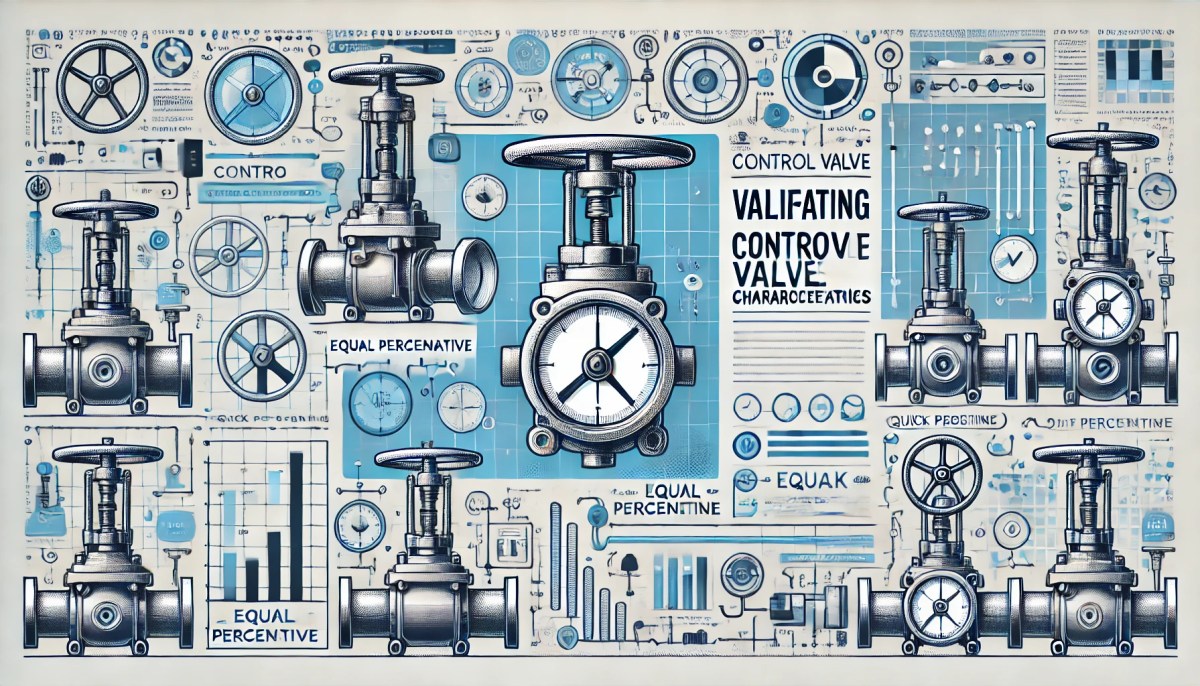Validating Control Valve Characteristics: A Comprehensive Guide
Control valves play a critical role in regulating flow, pressure, temperature, and other process variables in industrial systems. To ensure optimal performance, it is essential to validate the inherent flow characteristic of the control valve and align it with the specific requirements of your process. This post explores the different types of valve characteristics—linear, equal percentage, and quick opening—and provides guidance on their selection and validation.

1. What Are Control Valve Characteristics?
Control valve characteristics describe the relationship between the valve position (or stem travel) and the resulting flow rate under constant pressure conditions. They are an inherent property of the valve and determine how the valve responds to changes in input signals from the controller.
1.1 Why Valve Characteristics Matter
- Process Control Precision: The valve’s response must align with the dynamics of the process.
- Stability: Incorrect characteristics can cause oscillations or instability.
- Efficiency: Proper valve selection minimizes energy waste and wear.
2. Types of Control Valve Characteristics
2.1 Linear Characteristic
- Description: Flow rate changes proportionally with valve position.
- Behavior:
- At 50% valve opening, 50% of the maximum flow is achieved.
- The flow gain remains constant across the entire range.
- Applications:
- Processes requiring proportional control.
- Systems where the pressure drop across the valve is relatively constant.
- Example: Cooling water flow to a heat exchanger.
- Advantages:
- Simple to implement and predictable behavior.
- Limitations:
- Less effective for systems with varying pressure drops.
2.2 Equal Percentage Characteristic
- Description: Flow rate increases exponentially with valve position, resulting in small changes in flow at low openings and larger changes at higher openings.
- Behavior:
- At low valve openings, flow change is minimal.
- As the valve opens further, flow increases significantly.
- Provides approximately equal percentage change in flow for equal increments of valve travel.
- Applications:
- Wide-ranging flow applications with varying pressure drops.
- Systems where load changes require fine control at low flow rates and larger adjustments at high flow rates.
- Example: Steam control valves.
- Advantages:
- Handles varying loads effectively.
- Ideal for processes with non-linear demands.
- Limitations:
- More complex to size and tune compared to linear valves.
2.3 Quick Opening Characteristic
- Description: Provides a rapid increase in flow with minimal valve travel. Once open, further travel results in little additional flow change.
- Behavior:
- Maximum flow is achieved at a small percentage of valve travel.
- Applications:
- On/off applications where rapid response is critical.
- Emergency systems like safety relief or isolation valves.
- Example: Blowdown valves or emergency shutdown valves.
- Advantages:
- Instantaneous response for critical applications.
- Limitations:
- Not suitable for modulating control due to poor flow adjustability.
3. Steps to Validate Control Valve Characteristics
3.1 Analyze Process Requirements
- Identify the control objective:
- Is the system designed for proportional control, wide-range adjustments, or emergency shutdown?
- Evaluate the process dynamics:
- Are the pressure drop and flow demands constant or variable?
- Assess the rangeability:
- Determine the valve’s ability to control flow over a wide range of operating conditions.
3.2 Select the Appropriate Characteristic
- Match the valve characteristic with the process needs:
- Linear: Constant pressure drop, proportional control.
- Equal Percentage: Varying loads or non-linear system responses.
- Quick Opening: Fast-acting emergency applications.
3.3 Validate Performance Using Calculations
- Perform sizing calculations to ensure the selected valve can handle the required flow range.
- Use the inherent characteristic curve provided by the manufacturer to predict valve performance.
- Verify the installed characteristic, which accounts for system pressure drops.
3.4 Simulate Valve Behavior
- Use dynamic simulation tools (e.g., HYSYS, Aspen, or process control software) to evaluate the valve’s response under real operating conditions.
- Simulate common scenarios such as load changes, startup, and shutdown.
3.5 Perform Field Testing
- Conduct field tests during commissioning to validate the valve’s performance:
- Measure flow, pressure, and valve position at different setpoints.
- Confirm that the valve responds predictably and maintains process stability.
4. Comparing Valve Characteristics
| Characteristic | Flow Behavior | Best Use Case | Example Application |
|---|---|---|---|
| Linear | Proportional flow changes. | Systems with constant pressure drops. | Cooling water, fuel supply to burners. |
| Equal Percentage | Exponential flow changes. | Processes with variable loads. | Steam flow, chemical injection. |
| Quick Opening | Rapid flow increase. | On/off or emergency systems. | Blowdown, emergency shutdown valves. |
5. Common Mistakes to Avoid
- Incorrect Characteristic Selection:
- Using a linear valve for a system with highly variable loads can cause instability.
- Ignoring Pressure Drop Changes:
- Failure to account for changing system pressure drops can result in poor valve performance.
- Overlooking Installed Characteristics:
- The valve’s behavior in the actual system may differ from its inherent characteristic due to external factors like piping and upstream equipment.
6. Best Practices for Validation
- Consult Manufacturers:
- Use manufacturer-provided data and tools to verify valve performance.
- Perform Detailed Sizing:
- Use appropriate sizing equations and tools to ensure the valve meets flow and pressure requirements.
- Involve Process Engineers:
- Collaborate with process engineers to align valve characteristics with system needs.
- Use Advanced Diagnostics:
- Select valves with diagnostic capabilities to monitor performance and detect issues.
7. Conclusion
Validating control valve characteristics is essential for achieving efficient and reliable process control. By understanding the differences between linear, equal percentage, and quick opening characteristics, you can select the right valve for your specific application. Proper validation during the design, simulation, and commissioning stages ensures that the valve will meet process requirements, minimize variability, and enhance overall system performance.
By applying these principles, you can optimize your control valve’s performance and maintain stable and efficient operations in your industrial processes.
